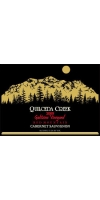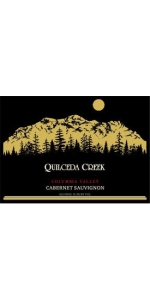Wine from Quilceda Creek Vintners

The Quilceda Creek Vintners Estate
The winery was founded in 1978 and is dedicated exclusively to produce world-class Washington State Cabernet Sauvignon.
“Alex Golitzin, nephew of famed enologist André Tchelistcheff, focues on Cab alone with spectacular results; cult wines sold via mailing list.” - Anthony Dias' blue pocket guide to wine 2006
"Quilceda Creek Vintners remains a model of consistency. In the outstanding 2005 vintage, Quilceda Creek’s Cabernet Sauvignon remains the benchmark for what can be achieved in Washington and the United States. Some good news from the winery is that beginning with the 2006 vintage, there will be a new vineyard designate, a Cabernet Sauvignon from the Palengat Vineyard in the Horse Heaven Hills AVA. The vines are only 7 years old but the potential is enormous as a taste from barrel attests." - Wine Advocate (Issue 177, July 2008)
The Quilceda Creek Vintners Vineyard
The grapes are sourced from 5 different vineyards: Champoux, Ceil du Cheval, Klipsun, Tapteil, Galitzine Estate, all in Benton City. They produce Cabernet Sauvignon, Merlot and Columbia Valley Red Wine.
Since the founding in 1978, Quilceda Creek has dedicated itself to one thing: producing world-class Cabernet Sauvignon. Director of Winemaking Paul Golitzin believes that the winery’s greatest assets are the vineyards of the Columbia Valley. Through vineyard ownership and control, and through precision farming, they are able to grow and produce the highest caliber Cabernet Sauvignon. In award of their relentless pursuit of producing perfect Cabernet Sauvignon, Quilceda Creek has received seven 100 Point ratings from Wine Advocate, three 100 Point ratings from Owen Bargreen, two 100 Point ratings from Decanter and three Top Ten Wines of the Year from Wine Spectator.
The 2021 Quilceda Creek Cabernet Sauvignon is a wine for the ages. Potent aromas jump out of the glass, showing framboise candy, black tea, and a strong classic note of sandalwood. Savory cumin, sage, and garrigue round out this powerful nose. The palate is sweet and velvety, leading to an amazing crescendo of power and refinement.
Review:
The flagship 2021 Cabernet Sauvignon Columbia Valley is 100% Cabernet Sauvignon (90% from Champoux Vineyard and 10% from Mach One Vineyard) raised all in new barrels. It's slightly deeper hued than the CVR and has a stunning nose of blackcurrants, smoked tobacco, toasted spices, and graphite with a beautiful varietal, herbal undertone that comes through with time in the glass. Deep, rich, full-bodied, and velvety textured, this thrilling Washington State Cabernet Sauvignon will benefit from 4-5 years of bottle age and evolve for two decades. This is unquestionably up with the greatest vintages of this cuvée ever made.
-Jeb Dunnuck 100 Points
The 2021 Columbia Valley Cabernet Sauvignon from Quilceda Creek is once again another monumental release. It begins to impress with its striking perfumed aromas of ripe blackberries and dark currants, which are joined together with crushed violets, graphite, tobacco, and hints of licorice all developing in the glass. On the palate this possesses a gorgeous full body that is impeccably structured with beautifully polished tannins that result in an utterly seamless texture. This continues to impress with its excellent balance and concentration combined with remarkable overall power and finesse. There is a lovely touch of underlying acidity that ties it all together and provides a wonderful sense of freshness that carries it into the lavish finish. While this is already stunning in its youth, it is ultimately an age worthy wine which will go on to evolve for decades. Quilceda Creek sets the benchmark for Cabernet Sauvignon in Washington, and this is a clear example of why they have earned that reputation.
- back
Selected Options
Wineries
Categories
Pricing
Countries
Regions
Grape Types
Wineries
Organic/Free Shipping
“1752” is the name of the Damilano Barolo Cannubi Riserva, in honor of the year in which the historic bottle was first marked “Cannubi”. It still exists today perfectly conserved by the Manzone family in Bra, close to Barolo. The bottle is clearly marked as being of “1752” vintage, indicating that Cannubi historically precedes Barolo.
About the Vineyard:
The Cannubi Cru is in found within one of the 6 core zones which comprise a UNESCO heritage site in Italy. A mixture of Tortonian and Helvetian calcareous marl gives the grapes intense aromas of cherry, plum and tobacco, rose and violet in sequence. Its low potassium and high calcium/magnesium content offer the wine a fine and polished touch. The vineyard is located at about 270 m. a.s.l. and has a south-east sun exposure. Barolo Riserva Cannubi 1752 It is a small plot of about 2 hectares of Nebbiolo vines, currently between 30 and 50 years of age.
Tasting Notes:
Garnet ruby red in color, the bouquet is intense and balanced, with notes of violet, red fruit, cherry and plum, spices, liquorice, cocoa, leather and tobacco. Dry, robust, full-bodied, very persistent, rich and velvety
Food Pairing:
This wine is excellent with typical piedmontes pasta (tajarin, ravioli); perfect with red meat, braised and roast meat, game and absolutely ideal with all types of cheeses.
Review:
“Incredible, reserved ripeness and depth already evident on the nose after one whiff, offering plum, cedar, rose hip, sandalwood, and licorice. Full-bodied with superb depth of fruit and an abundance of polished tannins that give the wine poise and grace, even though it’s long and powerful. The quality of the tannins are exceptional. Sheer and refined. This comes from the center of Cannubi.”
-James Suckling 99 Points
Clos Saint-Jean is a 41-hectare estate in Châteauneuf-du-Pape run by brothers Vincent and Pascal Maurel. Considered by many critics and wine-writers as the preeminent estate espousing the modern style of winemaking in Châteauneuf, this cellar is one of the oldest in the region, having been founded in 1900 by the greatgreat-grandfather of Vincent and Pascal, Edmund Tacussel. A short time after its founding and well before the AOP of Chateauneuf-du-Pape was created in 1923, Edmund began bottling estate wines in 1910.
The farming at Clos Saint-Jean is fully sustainable due to the warm and dry climate, which prevents the need for chemical inputs. Instead, Vincent and Pascal employ organic methods for pest control, mainly pheromones, to prevent pests from taking up residence in their vines, a process called amusingly enough in French, confusion sexuelle. The vines tended manually, and harvest is conducted in several passes entirely by hand.
Combe des Fous literally means, the hill of the fool. The hill, in this case, is located in the far southern reach of Le Crau which was left barren for many centuries because the layer of galets was so exceedingly deep that everyone assumed vines could never survive there. The fool in this situation is Edmund Tacussel, the great-great-grandfather of Vincent and Pascal Maruel who planted a Grenache vineyard on this site in 1905. That old-vine Grenache form the heart of this cuvée with a small amount of Syrah, Cinsault and Vaccarèse. La Combe des Fous is only made in the best vintages.
Review:
This has good concentration and energy to the dense core of dark fruit and bitter cherry, with great poise and elegance despite its ripeness (an impressive feat for the vintage). Guided by finely crushed mineral accents and tannins, this reveals pretty high-toned floral notes and leafy tobacco. Grenache, Syrah, Mourvedre, Cinsault, Vaccarese and Muscardin. Drink now through 2032. 900 cases made.
-Wine Spectator 95 Points





